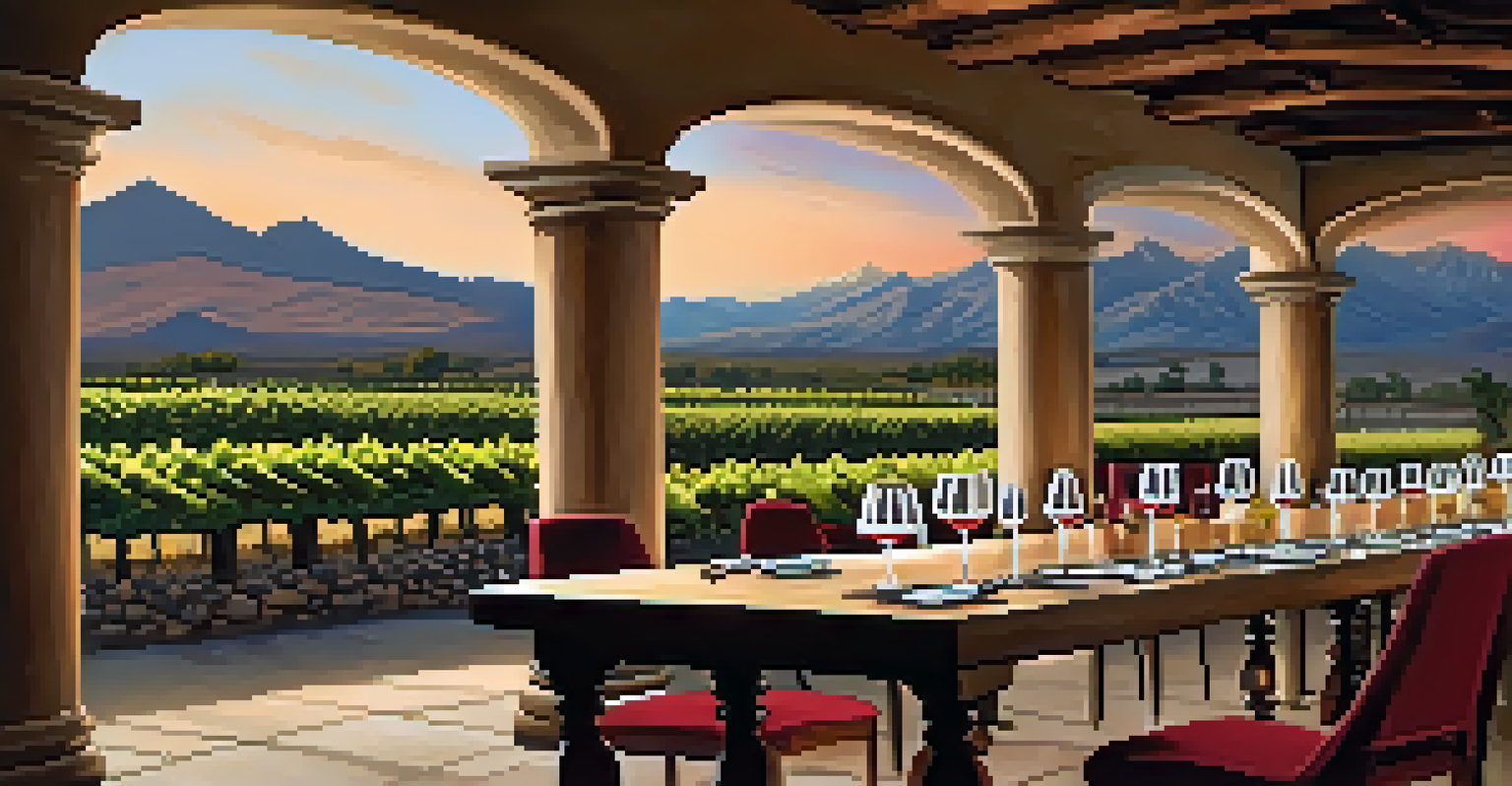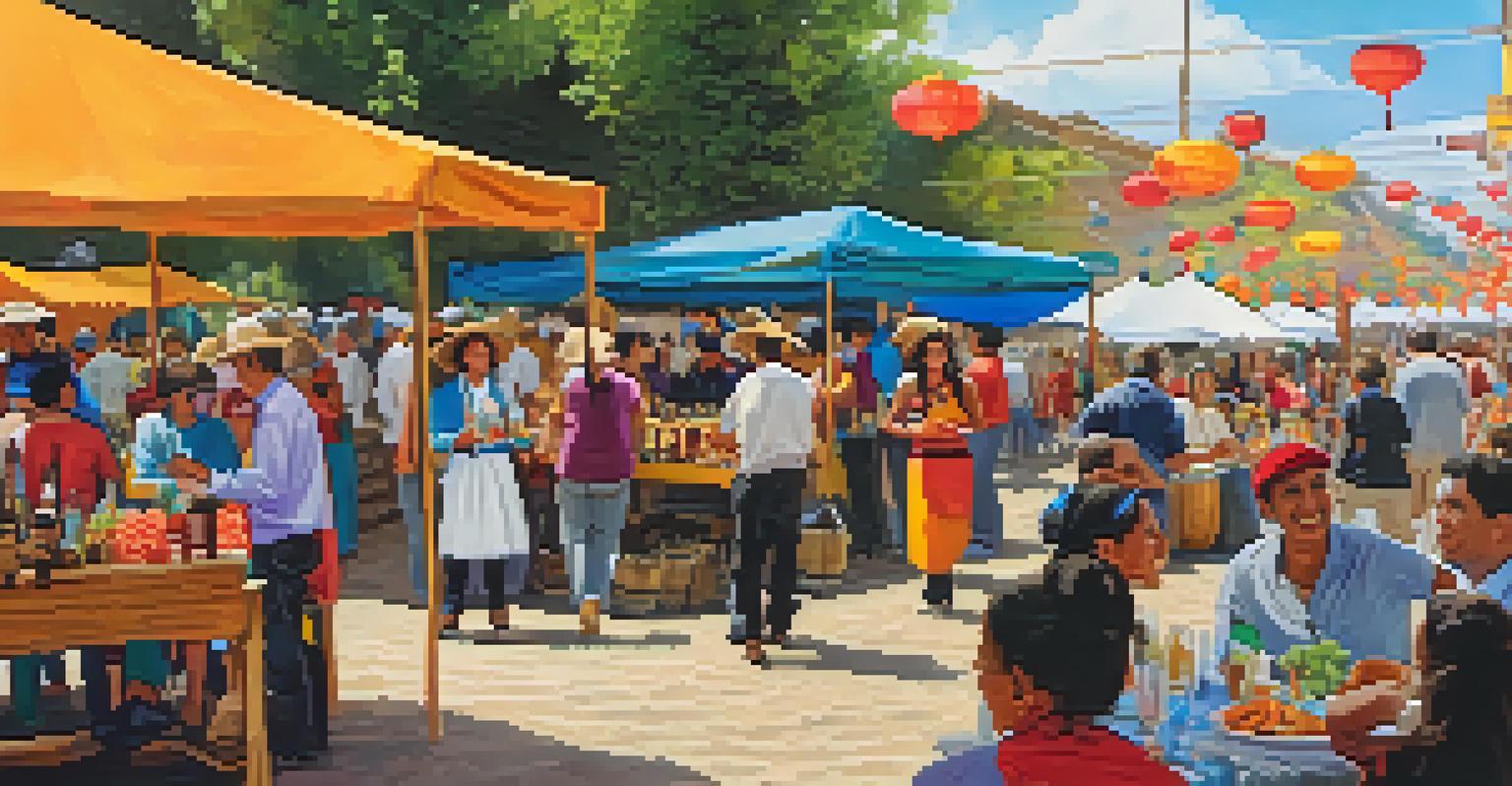Exploring the Unique Wine Regions of Peru: A Comprehensive Guide

An Overview of Peru's Wine Industry and Its Growth
Peru's wine industry, though often overshadowed by its neighbors, has been gaining recognition for its unique varietals and rich history. The country's diverse microclimates allow for a range of grapes to flourish, making it a hidden gem for wine enthusiasts. Over the past few decades, there has been a significant investment in viticulture, enhancing the quality and variety of wines produced.
Wine is sunlight, held together by water.
The growth of the wine industry is also tied to the revival of ancient winemaking techniques, blending tradition with modern practices. This fusion not only preserves cultural heritage but also attracts a new generation of winemakers eager to experiment. As a result, Peru's vineyards are becoming known for their innovative blends and organic farming methods.
Additionally, Peru's wine is closely linked to its culinary scene, with local wines often paired with traditional dishes. The symbiotic relationship between food and wine enhances the overall experience for visitors, making wine tourism an exciting venture. Overall, Peru's wine industry is on the rise, inviting both connoisseurs and novices to explore its offerings.
Key Wine Regions: Exploring Ica
Ica is arguably the most famous wine region in Peru, known for its warm climate and sandy soils that create ideal conditions for grape growing. It is home to a variety of vineyards, producing wines from grapes like Quebranta and Torontel, which are essential for Pisco production, Peru's iconic spirit. The region's wineries offer tours that include tastings and insights into the winemaking process, making it a popular destination for wine lovers.

One standout vineyard in Ica is Tacama, which has been producing wine since the 16th century. Visitors can enjoy a scenic tour of the estate, followed by tastings of their renowned wines, including elegant reds and refreshing whites. The vineyard's commitment to sustainable practices also adds to its appeal, attracting environmentally conscious travelers.
Peru's Wine Industry is Growing
Peru's wine industry is gaining recognition due to its unique varietals and the blend of ancient techniques with modern practices.
In addition to wine tasting, Ica boasts stunning landscapes, including the famous Huacachina oasis and the Paracas National Reserve. This combination of natural beauty and rich viticulture makes Ica a must-visit for anyone looking to experience the best of Peru's wine culture. Whether you're sipping wine at sunset or exploring the dunes, Ica offers a unique adventure.
Discovering the Rich Flavors of Arequipa
Arequipa is another prominent wine region, often referred to as the 'White City' due to its stunning architecture made from white volcanic stone. The region's high altitude and diverse terroir contribute to the distinct flavors found in its wines. Here, you'll find an impressive array of varietals, including Malbec and Syrah, which thrive in the cooler climate.
Good wine is a good familiar creature if it be well used.
One of the standout wineries in Arequipa is Bodega Tabali, known for its commitment to producing high-quality wines that reflect the region's unique characteristics. Visitors can tour the vineyards and cellar, enjoying tastings that highlight the rich, fruity flavors of the wines. The breathtaking backdrop of the Andes mountains adds to the allure of this experience.
Moreover, Arequipa's culinary scene is vibrant, with local dishes that pair beautifully with its wines. The region's famous dishes, such as rocoto relleno and chupe de camarones, can be perfectly complemented by a glass of Arequipa wine. This delightful fusion of flavors makes Arequipa a fantastic destination for food and wine enthusiasts alike.
The Emerging Wine Scene in Moquegua
Moquegua is an up-and-coming wine region that is starting to attract attention for its unique terroir and innovative winemakers. Nestled between the Andes and the Pacific coast, Moquegua benefits from a climate that offers warm days and cool nights, perfect for grape maturation. The region is gaining a reputation for producing exceptional wines, particularly from the Tannat grape, known for its deep color and bold flavors.
One of the key players in Moquegua is Bodega Santiago Queirolo, which focuses on sustainable practices and high-quality production. The winery offers tours that educate visitors about their winemaking techniques, as well as tastings of their diverse range of wines. This commitment to quality and sustainability is beginning to set Moquegua apart as a noteworthy wine destination.
Key Regions Showcase Diverse Wines
Regions like Ica, Arequipa, and Moquegua are renowned for their distinct wines, each offering unique flavors and experiences for visitors.
Visitors to Moquegua can also enjoy the breathtaking landscapes and rich cultural heritage, making it more than just a stop for wine tasting. The region’s historical sites, such as the pre-Incan ruins of Tiahuanaco, add depth to the travel experience. As Moquegua continues to develop its wine scene, it promises to be a destination worth exploring.
The Role of Pisco in Peru's Wine Culture
Pisco, a type of brandy, is deeply embedded in Peru's culture and plays a significant role in the country’s wine heritage. Made from fermented grape juice, Pisco is often enjoyed straight or used in cocktails, with the Pisco Sour being the most famous. The production of Pisco is concentrated in regions like Ica and Arequipa, where the local grapes are ideal for crafting this beloved spirit.
The process of making Pisco is an art form, involving careful selection of grapes, fermentation, and distillation. Many wineries also produce Pisco, offering tastings that highlight the differences between various types, including Pisco puro, acholado, and mosto verde. This exploration of Pisco adds another layer to the wine experience in Peru, showcasing a unique aspect of local craftsmanship.
Moreover, Pisco is often featured in cultural celebrations and traditional gatherings, making it an integral part of Peruvian life. Whether enjoyed in a festive setting or as part of a quiet evening, Pisco embodies the spirit of Peru. For wine enthusiasts, understanding Pisco’s role enhances the overall appreciation of Peru's wine culture.
Wine Festivals: Celebrating Peru's Wine Heritage
Peru's wine festivals offer a vibrant celebration of the country's rich viticultural heritage, attracting locals and tourists alike. Events like the annual Festival de la Vendimia in Ica showcase the best of Peru's wine, featuring tastings, live music, and traditional food. This lively atmosphere creates a perfect opportunity to experience the culture and community surrounding Peruvian winemaking.
During these festivals, visitors can meet winemakers, learn about their craft, and sample a variety of wines. Many festivals also include competitions, where local wineries showcase their finest offerings, adding an element of friendly rivalry. Such events not only promote local wines but also unify the community in celebrating their shared passion for viticulture.
Pisco Enhances Wine Culture
Pisco, a beloved Peruvian brandy, plays a significant role in the country's wine culture, enriching the overall tasting experience.
In addition to Ica, Arequipa and Moquegua also host their own wine festivals, making it easy to find an event throughout the year. These festivals provide a unique insight into the local culture, allowing attendees to immerse themselves in the traditions and flavors of Peru. For anyone looking to explore Peru's wine regions, attending a wine festival is a fantastic way to start.
Tips for Wine Lovers Visiting Peru
Planning a trip to explore Peru's wine regions can be an exciting adventure, but a few tips can enhance the experience. First, consider timing your visit during the grape harvest season, which typically runs from February to April. This is when vineyards are bustling with activity, and visitors can witness the winemaking process firsthand, making for a memorable experience.
Additionally, it’s helpful to arrange winery tours in advance, as many of the best vineyards offer guided experiences that can fill up quickly. Look for tours that include tastings, food pairings, and opportunities to learn about sustainable practices in winemaking. Engaging with the winemakers and staff can provide insightful perspectives on the local wine culture.

Lastly, don’t forget to explore the local cuisine while visiting the wine regions. Pairing the right food with Peruvian wine can elevate your tasting experience significantly. From traditional dishes to modern interpretations, embracing the culinary scene alongside the wine will create a well-rounded and unforgettable journey through Peru's unique wine landscape.
Conclusion: The Future of Wine in Peru
The future of wine in Peru looks promising, with a growing number of wineries embracing innovation while respecting traditional methods. As more travelers discover the unique offerings and diverse flavors of Peruvian wines, the industry is likely to expand further, attracting international attention. This growth not only benefits the wineries but also the local communities that depend on viticulture.
Moreover, the increasing interest in sustainable and organic practices in winemaking will likely play a crucial role in shaping Peru's wine future. As consumers become more conscious of environmental impacts, wineries that prioritize eco-friendly methods will stand out. This shift can enhance the quality of the wines produced while benefiting the land and its people.
Peru's Wine Industry is Rising
Peru's wine industry is gaining recognition for its unique varietals and innovative practices, making it an exciting destination for wine enthusiasts.
Ultimately, exploring the wine regions of Peru is not just about the wine itself; it’s about experiencing the culture, landscapes, and stories behind each bottle. Whether you're a seasoned wine enthusiast or a curious traveler, Peru's wine regions offer a rich tapestry of experiences that promise to delight and inspire. As the world turns its attention to Peru, the country is ready to share its hidden treasures with the world.